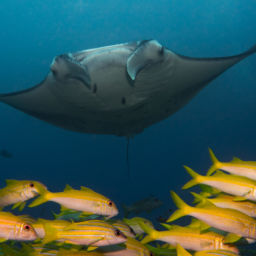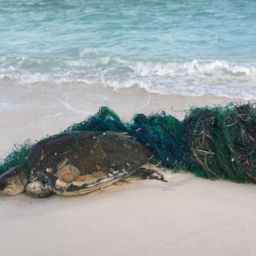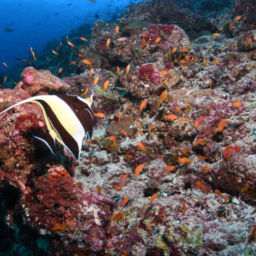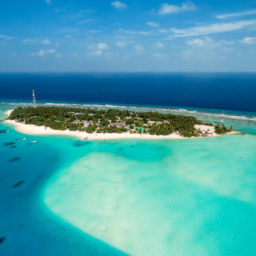10In the north-central Indian Ocean sit the Maldives, 1,200 islands forming an archipelago of 27 atolls. Only a handful of these tropical islands are occupied, and the country has become an idyllic destination for honeymooning couples. Palm-fringed, white-sand beaches are home to luxurious resorts offering a romantic escape. But it’s not just romance that attracts tourists — the north Maldives is also quite popular with scuba divers. In the center of the country is North Kaafu — better known as North Male Atoll — the most developed atoll and the hub of Maldives tourism.
Here you’ll find the most explored and well-known dive sites in the region. Healthy reefs, drop-offs, caves, deep current-swept channels, and an abundance of marine life are just waiting to be discovered by divers of all levels.
Banana Reef
This banana-shaped reef was one of the first sites discovered and is still a firm favorite with local divers, as it offers some of the best coral coverage in the Maldives. Large thickets of pristine Acropora coral and huge sea fans occupy the sloping reef. Watch for large grouper, bluestripe snapper, angelfish, morays, and lobster hiding in the crevices.
As you drift with the current at depths between 33 and 85 feet (10 and 25 m), you’ll enjoy a varied topography including overhangs, caves, and caverns. At the eastern end of Banana Reef is the ‘washing machine,’ where an enormous school of bannerfish hangs in the current. Inexperienced divers should observe the bannerfish from a distance as the current in this area can be very strong.
Manta Point
As the name suggests, Manta Point offers the area’s best chance of seeing these majestic creatures. Manta rays come in from the blue and queue above the shallow reef to visit one of three cleaning stations. By controlling your buoyancy and keeping your distance, you’ll see cleaner wrasse removing parasites and dead skin from the mantas’ body, mouth, and gills. Once the cleaners are done, the manta moves on to make room for the next one. It’s a truly amazing spectacle.
If you can drag your eyes away from the mantas, Manta Point has plenty more to offer. Large numbers of oriental sweetlips, Napoleon wrasse, hawksbill turtles, morays, and octopus occupy the reef. Out in the blue, you’re likely to see schools of jacks and barracuda while whitetip reef sharks rest on the sandy bottom. Manta Point is definitely one of the most exciting dives in North Maldives.
Maldive Victory wreck
In 1981, a 328-foot (100 m) Singaporean cargo ship sank on its journey to the Maldives. It now rests between 39 feet (12 m) and 115 feet (35 m) and has become a vibrant artificial reef, encrusted with sea fans and corals which countless species of marine animals now call home. Ghost pipefish, nudibranchs, soldierfish, and hawkfish take shelter among stunning corals. Also expect to spot batfish, large puffers, and schools of fusiliers. Turtles often perch on the deck of the ship.
The Maldive Victory wreck is located in a channel and currents are particularly strong in this area. The ship provides you with some shelter while exploring but make sure you have plenty of air remaining for the ascent and safety stop.
Girifushi Thila
Girifushi Thila, or Rainbow Reef, is recognized as one of the best dive sites in the northern Maldives. ‘Thila’ means submerged pinnacle, and this one’s shallowest point is around 39 feet (12 m). As you drift along on the current, you’ll see an amazing array of brightly colored soft corals interspersed with tunicates and gorgonian fans.
The topography includes many overhangs, caves, and swim-throughs, including ‘the chimney,’ which rises from 85 to 33 feet (25 m to 10 m). These various rock formations offer the chance to escape from the current and observe snappers, lionfish, jacks, angelfish, and yellow-mouthed morays. Eagle rays, tuna, barracuda, and gray reef sharks also frequently visit Girifushi Thila. Liveaboards will often dive this site more than once due to popular demand.
Hans Haas Place
Free from the currents that are a staple of many dive sites in the north Maldives is Hans Haas Place. This 328-foot (100 m) reef starts at 16 feet (5 m), drops down to 100 feet (30 m), and plays host to several overhangs and caverns.
The overhangs have ceilings of purple sea fans and soft corals that hide soldierfish, trumpetfish, and groupers. Hans Haas Place is also a great place to see some less-common species, including scrawled filefish, leaf scorpionfish, and freckled hawkfish. This protected marine area offers one dive site that divers of all levels can enjoy.
How to get the most out of diving in the north Maldives
If you’re looking for a relaxing vacation and the opportunity to do a few fun dives, staying at a resort in North Male Atoll is your best option. Every resort will cater for divers and some are even dedicated to scuba diving. However, without a doubt, the way to get the most out of diving in North Maldives is on a liveaboard.
It’s not a cheap destination but a dive safari is probably more economical than booking into a resort. It also offers you the opportunity to visit some of the more far-flung dive sites in the northern atolls. You can find liveaboards to suit the majority of budgets whether you’re after no-frills or a luxury cruise.
When is the best time to dive the north Maldives?
Water temperatures are comfortable year-round in the north Maldives and average between 80 and 86 F (27 and 30 C). December to May is the dry season and this is when currents pick up, improving visibility and bringing in the larger pelagic marine life. During the southwest monsoon from June to November, there’s more chance of rain and high winds and sea conditions can be unpredictable.
Resort dive centers operate year-round. Even if the weather and conditions are not ideal for diving some of the remote sites, there are plenty of sheltered sites nearby to enjoy. However, liveaboards only run in the north Maldives between September and April.
January to April offers ideal diving conditions with excellent visibility and calm seas, but no matter when you choose to visit the north Maldives, you are guaranteed some world-class diving.










